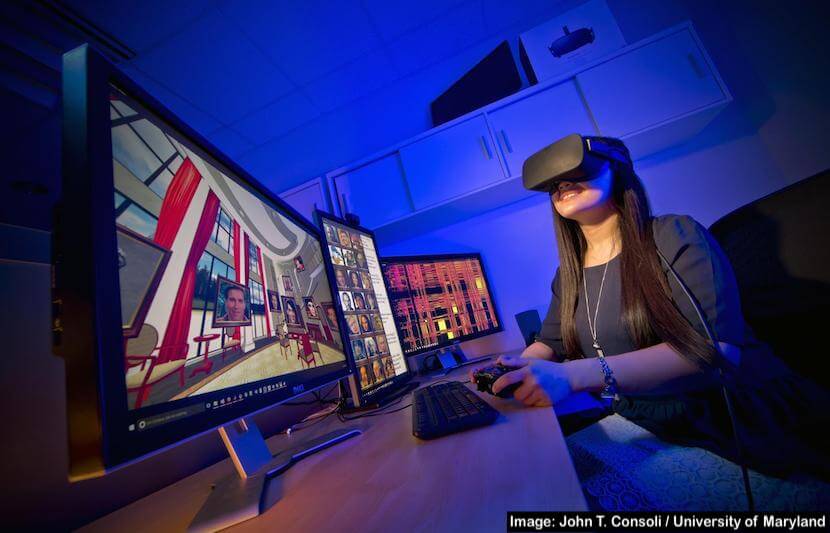People can remember information better when it is presented through an immersive, virtual reality (VR) experience rather than a two-dimensional platform, a new study suggests.
Researchers at the University of Maryland conducted one of the first in-depth studies on the effects of learning through a virtual environment, pointing to the prospect of using VR technology as a means to educate or train people in various tasks.
The study is published in the journal Virtual Reality.
Using a memory palace
To conduct the study, the UMD team utilized the concept of a “memory palace,” or the idea that people recall an object by placing it in an imaginary physical space, such as a building or town.
Referred to as mnemonic encoding, this method takes advantage of the human brain’s natural ability to spatially organize thoughts and memories.
“Prior research by others has shown that people tend to do better with recall ability if they’re able to leverage what they’re seeing relative to the position of their own body. ‘How is the information oriented to where I am sitting or standing? Is it above me or lateral to my position? And how far way?’ ” said Amitabh Varshney, a professor of computer science and dean of the College of Computer, Mathematical, and Natural Sciences at UMD.
Using this idea, the researchers recruited 40 volunteers, comprised of mostly UMD students unfamiliar with VR, and split them into two groups. While one group viewed information first through a VR headset and then on a desktop, the other did the opposite.
The study
Both groups were given photos of famous people, such as Abraham Lincoln, Hillary Clinton, Stephen Hawking, Arnold Schwarzenegger, and Marilyn Monroe, and told to familiarize themselves with their images.
Then, using the memory palace concept, the researchers showed participants the famous faces in two virtual locations: an interior room in an ornate palace and an external view of a medieval town.
In both places the famous people were positioned in different locations.
For example, in the ornate palace, Oprah Winfrey appeared at the top of a staircase, while Stephen Hawking was a few steps down, followed by Shrek. On the floor, Napoleon Bonaparte’s face was presented above a lavish wooden table, while Martin Luther King Jr. was placed in the center of the room.
Similarly, in the medieval town, Hillary Clinton was located on the left side of a building, with Mickey Mouse and Batman positioned at various heights on nearby platforms.
Both groups were given five minutes to navigate through each space.
To change their viewpoint, the desktop users clicked a mouse, while the VR users turned their heads from side to side and up and down.
After five minutes, the scene went blank.
Two minutes later, the scene reappeared with numbered boxes where the faces had been.
The participants were then asked to remember which faced had been in each numbered location.
The findings
Overall, the researchers found an 8.8 percent improvement when participants used the VR headsets.
Additionally, 40 percent of participants scored at least 10 percent higher in their ability to recall the faces using VR over the desktop display.
In post-study questionnaires, all 40 participants said they were both comfortable and adept at navigating a desktop computer, but almost all of them said they preferred the VR environment as a learning platform.
Only two people reported that they felt uncomfortable using the VR technology. Instead, most people reported that the “immersive” aspect of the technology allowed them to focus better.
Real world applications
Currently, the researchers are working within the Maryland Blended Reality Center, a collaboration between UMD and the R Adams Cowley Shock Trauma Center in Baltimore, to build immersive-technology prototypes that could be used to train emergency medicine experts.
“We want to film actual cases at Shock Trauma using a special array of multiple cameras, and then let surgical residents immerse themselves into the scene to get a very life-like experience of this lifesaving work,” said Varshney. “We are also working with language analysts — people that need to have a very high-proficiency of foreign languages — to develop immersive VR training tools that can help people learn the nuances of certain foreign languages faster and better.”
Varshney believes that VR could someday be used for many purposes — from teaching elementary school kids about basic biology and astronomy to training surgical residents using specialized headsets.
“We believe there are many advantages to using VR — and augmented reality (AR) — over a two-dimensional learning platform,” he said. “If VR can, in fact, help people recall information better, then it will open up new modules for learning that could completely change how we internalize, work with, and deploy knowledge we have learned.”



